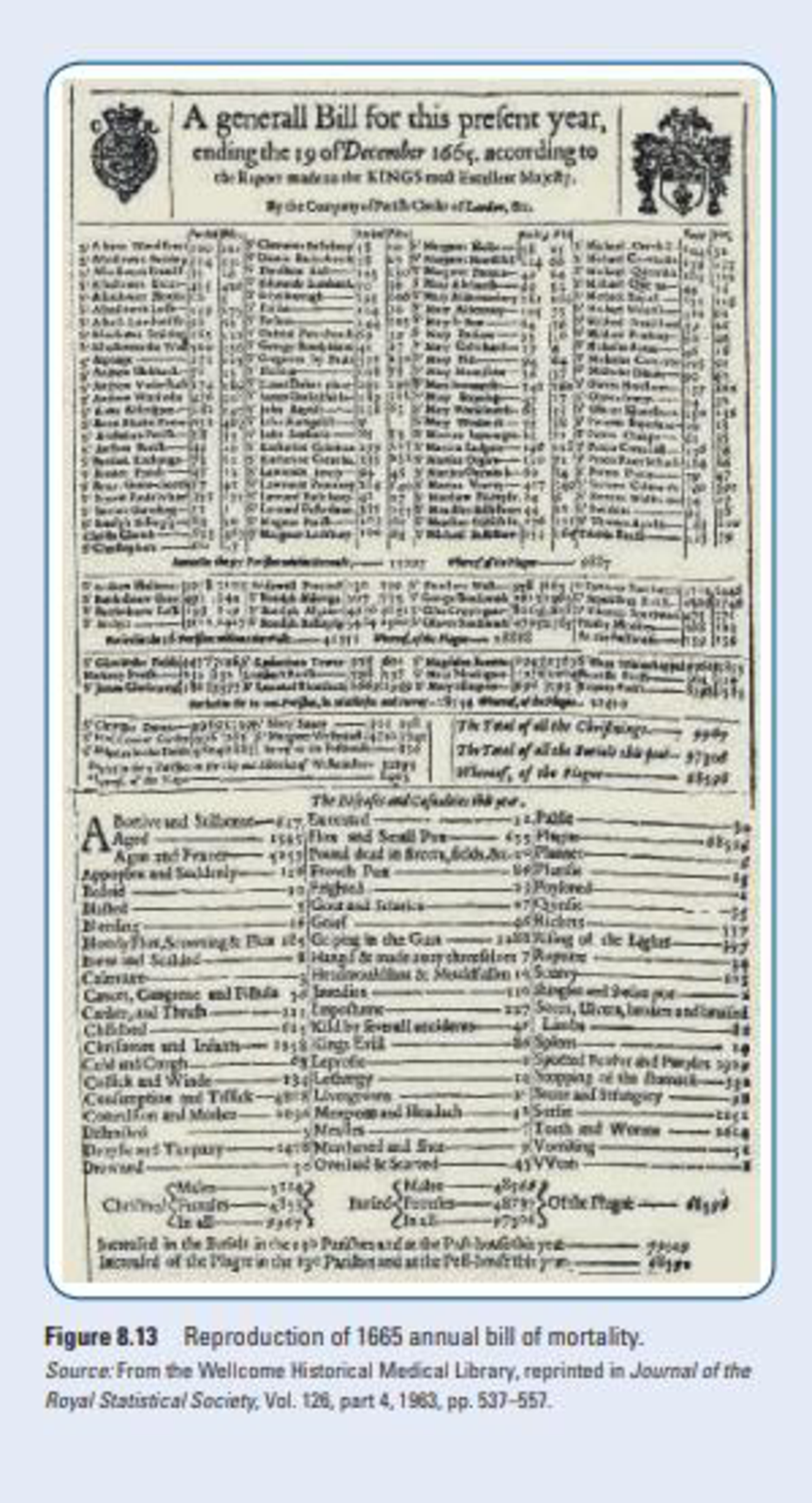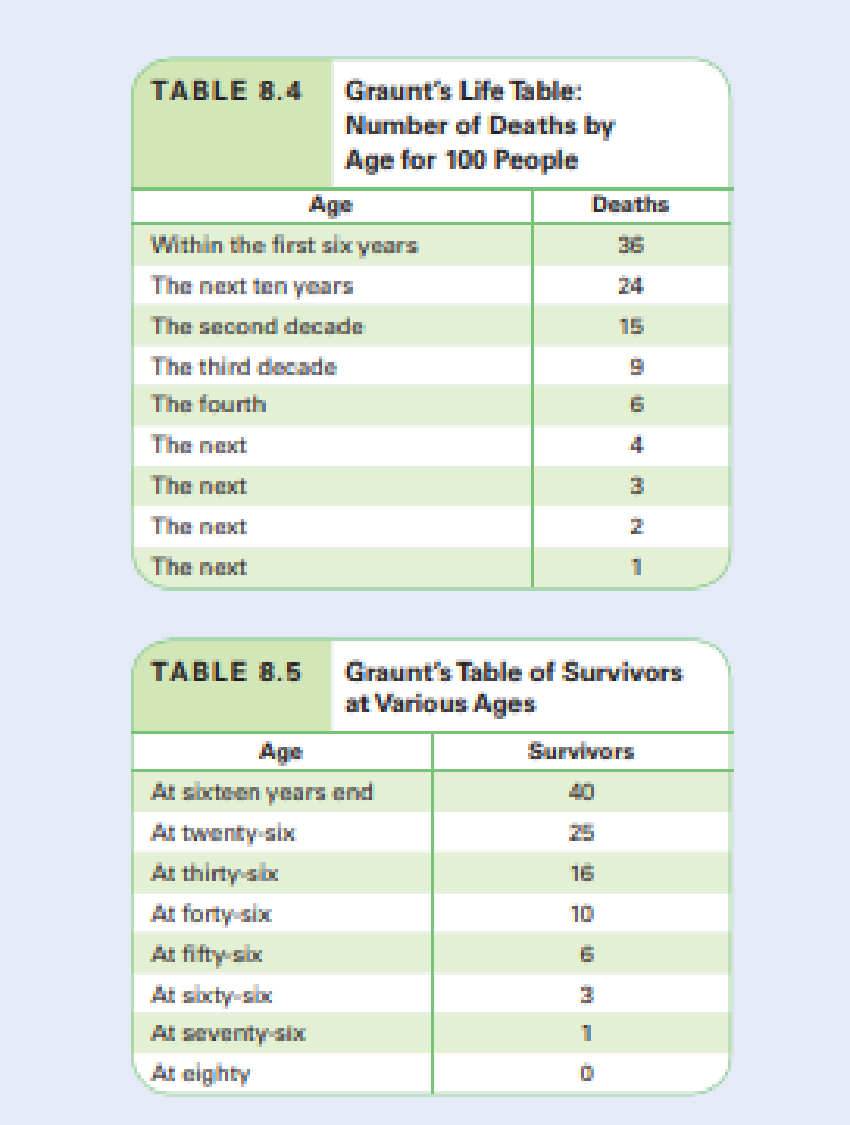
Concept explainers
History
Where Did Statistics Begin?
The origins of many disciplines are lost in antiquity, but the roots of statistics can be identified with some certainty. Systematic record keeping began in London in 1532 with weekly data collection on deaths. Later in the same decade, official data collection on baptisms, deaths, and marriages began in France. In 1608, the collection of similar vital statistics began in Sweden. Canada conducted the first official census in 1666.
Of course, statistics is more than the collection of data. If there is a founder of statistics, that person must be someone who worked with the data in clever and systematic ways and who used the data to reach conclusions that were not previously evident. Many experts believe that an Englishman named John Graunt deserves the title of the founder of statistics.
John Graunt was born in London in 1620. As the eldest child in a large family, he took up his father’s business as a draper (a dealer in clothing and dry goods). He spent most of his life as a prominent London citizen, until he lost his house and possessions in the Fire of London in 1666. Eight years later, he died in poverty.
It’s not clear how John Graunt became interested in the weekly records of baptisms and burials—known as bilk of mortality—that had been kept in London since 1563. In the preface of his book Natural and Political Observations on the Bills of Mortality, he noted that others “made little other use of them” and wondered “what benefit the knowledge of the same would bring to the World.” He must have worked on his statistical projects for many years before his book was first published in 1662.*
Graunt worked primarily with the annual bills, which were year-end summaries of the weekly bills of mortality. Figure 8.13 shows the annual bill for I66S (the year of the Great Plague). The lop third of the bill shows the numbers of burials and baptisms (christenings) in each parish. Total burials and baptisms arc noted in the middle of the bill, with deaths due to the plague recorded separately. The lower third of the bill shows deaths due to a variety of other causes, with totals given for males and females.

Graunt was aware of rough estimates of the population of London that were made periodically for taxation purposes, but he must have been skeptical of one estimate that put the population of London at 6 or 7 million in 1661. Using the annual bills, comparing burials and baptisms, and estimating the density of families in London (with an average family size of eight), he arrived at a population estimate of 460,000 by three different methods—quite a drop from 6 or 7 million? He also found that the population of London was increasing while the populations of towns in the country side were decreasing, showing an early trend toward urbanization. He raised awareness of the high rates of infant mortality. He also refuted a popular theory that plagues arrive with new kings.
Graunt’s most significant contribution may have been his construction of the first life table. Although detailed data on age at death were not available. Graunt knew that of 100 new babies. “36 of them die before they be six years old. and that perhaps but one survived) 76.” With these two data points, he filled in the intervening years as shown in Table 8.4, using methods that he did not fully explain.
With estimates of deaths for various ages, he was able to make the companion table of survivors shown in Table 8.5. Although some modem statisticians have doubted the methods used to construct these tables. Graunt appears to have appreciated their value and anticipated the actuarial tables now used by life insurance companies. It wasn’t until 1693 that Edmund Halley, of comet fame, constructed life tables using age-based mortality rates.
*Some historians claim that Graunt’s book was actually written by his lifelong friend and collaborator William Petty, though most statisticians believe Graunt wrote his own book. Either way, we know that Petty continued Graunt’s work, publishing later editions of Graunt’s book and creating the field of “political arithmetic,” which we now call demography.


Do you think that records of burials and baptisms would have given accurate counts of actual births and deaths? Why or why not?
Want to see the full answer?
Check out a sample textbook solution
Chapter 8 Solutions
Statistical Reasoning for Everyday Life Plus MyLab Statistics with Pearson eText -- 18 Week Access Card Package (5th Edition)
- I need help with this problem and an explanation of the solution for the image described below. (Statistics: Engineering Probabilities)arrow_forward310015 K Question 9, 5.2.28-T Part 1 of 4 HW Score: 85.96%, 49 of 57 points Points: 1 Save of 6 Based on a poll, among adults who regret getting tattoos, 28% say that they were too young when they got their tattoos. Assume that six adults who regret getting tattoos are randomly selected, and find the indicated probability. Complete parts (a) through (d) below. a. Find the probability that none of the selected adults say that they were too young to get tattoos. 0.0520 (Round to four decimal places as needed.) Clear all Final check Feb 7 12:47 US Oarrow_forwardhow could the bar graph have been organized differently to make it easier to compare opinion changes within political partiesarrow_forward
- 30. An individual who has automobile insurance from a certain company is randomly selected. Let Y be the num- ber of moving violations for which the individual was cited during the last 3 years. The pmf of Y isy | 1 2 4 8 16p(y) | .05 .10 .35 .40 .10 a.Compute E(Y).b. Suppose an individual with Y violations incurs a surcharge of $100Y^2. Calculate the expected amount of the surcharge.arrow_forward24. An insurance company offers its policyholders a num- ber of different premium payment options. For a ran- domly selected policyholder, let X = the number of months between successive payments. The cdf of X is as follows: F(x)=0.00 : x < 10.30 : 1≤x<30.40 : 3≤ x < 40.45 : 4≤ x <60.60 : 6≤ x < 121.00 : 12≤ x a. What is the pmf of X?b. Using just the cdf, compute P(3≤ X ≤6) and P(4≤ X).arrow_forward59. At a certain gas station, 40% of the customers use regular gas (A1), 35% use plus gas (A2), and 25% use premium (A3). Of those customers using regular gas, only 30% fill their tanks (event B). Of those customers using plus, 60% fill their tanks, whereas of those using premium, 50% fill their tanks.a. What is the probability that the next customer will request plus gas and fill the tank (A2 B)?b. What is the probability that the next customer fills the tank?c. If the next customer fills the tank, what is the probability that regular gas is requested? Plus? Premium?arrow_forward
- 38. Possible values of X, the number of components in a system submitted for repair that must be replaced, are 1, 2, 3, and 4 with corresponding probabilities .15, .35, .35, and .15, respectively. a. Calculate E(X) and then E(5 - X).b. Would the repair facility be better off charging a flat fee of $75 or else the amount $[150/(5 - X)]? [Note: It is not generally true that E(c/Y) = c/E(Y).]arrow_forward74. The proportions of blood phenotypes in the U.S. popula- tion are as follows:A B AB O .40 .11 .04 .45 Assuming that the phenotypes of two randomly selected individuals are independent of one another, what is the probability that both phenotypes are O? What is the probability that the phenotypes of two randomly selected individuals match?arrow_forward53. A certain shop repairs both audio and video compo- nents. Let A denote the event that the next component brought in for repair is an audio component, and let B be the event that the next component is a compact disc player (so the event B is contained in A). Suppose that P(A) = .6 and P(B) = .05. What is P(BA)?arrow_forward
 MATLAB: An Introduction with ApplicationsStatisticsISBN:9781119256830Author:Amos GilatPublisher:John Wiley & Sons Inc
MATLAB: An Introduction with ApplicationsStatisticsISBN:9781119256830Author:Amos GilatPublisher:John Wiley & Sons Inc Probability and Statistics for Engineering and th...StatisticsISBN:9781305251809Author:Jay L. DevorePublisher:Cengage Learning
Probability and Statistics for Engineering and th...StatisticsISBN:9781305251809Author:Jay L. DevorePublisher:Cengage Learning Statistics for The Behavioral Sciences (MindTap C...StatisticsISBN:9781305504912Author:Frederick J Gravetter, Larry B. WallnauPublisher:Cengage Learning
Statistics for The Behavioral Sciences (MindTap C...StatisticsISBN:9781305504912Author:Frederick J Gravetter, Larry B. WallnauPublisher:Cengage Learning Elementary Statistics: Picturing the World (7th E...StatisticsISBN:9780134683416Author:Ron Larson, Betsy FarberPublisher:PEARSON
Elementary Statistics: Picturing the World (7th E...StatisticsISBN:9780134683416Author:Ron Larson, Betsy FarberPublisher:PEARSON The Basic Practice of StatisticsStatisticsISBN:9781319042578Author:David S. Moore, William I. Notz, Michael A. FlignerPublisher:W. H. Freeman
The Basic Practice of StatisticsStatisticsISBN:9781319042578Author:David S. Moore, William I. Notz, Michael A. FlignerPublisher:W. H. Freeman Introduction to the Practice of StatisticsStatisticsISBN:9781319013387Author:David S. Moore, George P. McCabe, Bruce A. CraigPublisher:W. H. Freeman
Introduction to the Practice of StatisticsStatisticsISBN:9781319013387Author:David S. Moore, George P. McCabe, Bruce A. CraigPublisher:W. H. Freeman





